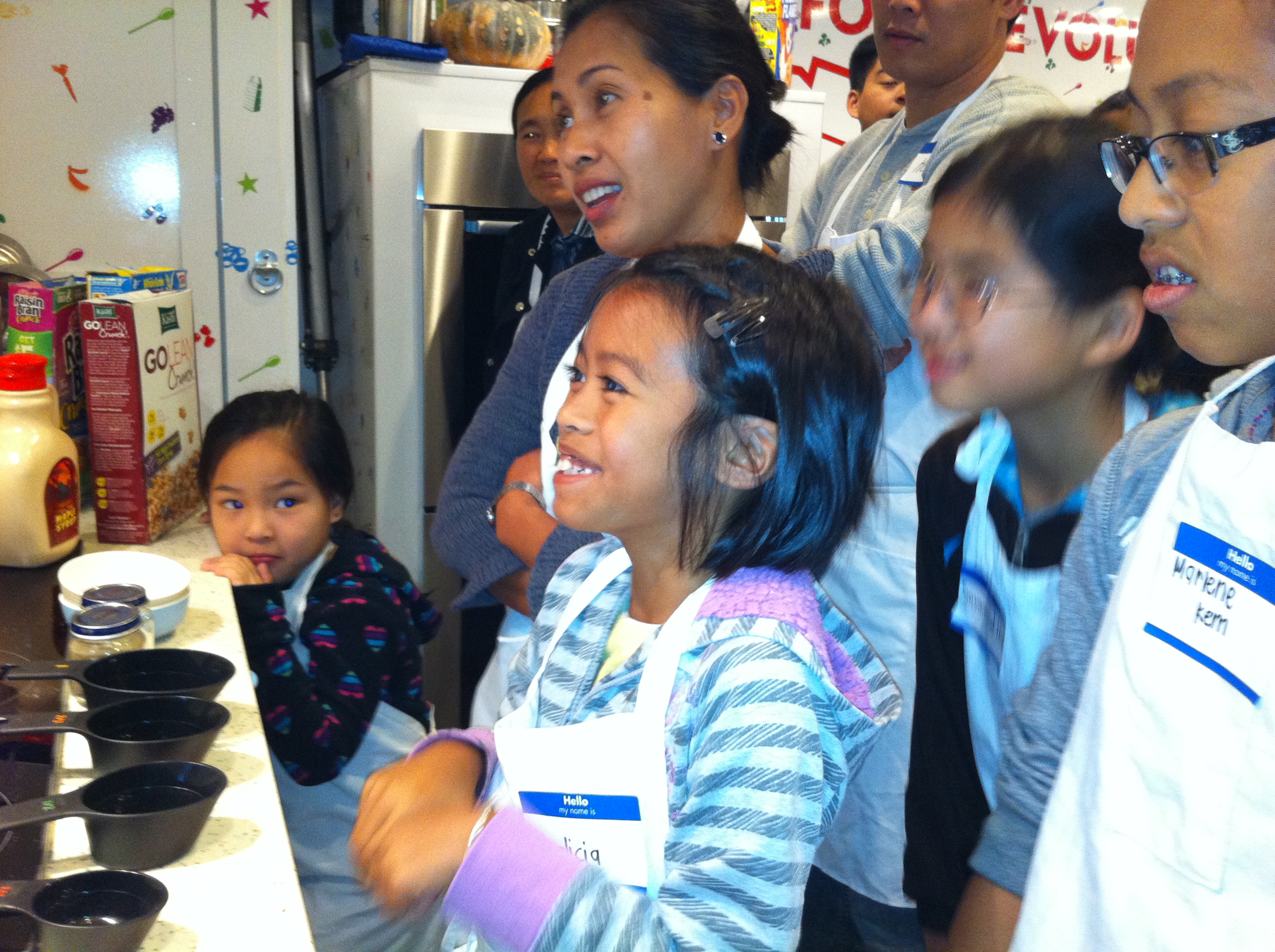

By Jessica Portner, California Health Report
“Today we are going to do breakfast,” said Henry Perez to a group of a dozen Cambodian children and adults inside a mobile kitchen tucked onto the parking lot at Long Beach City College recently. “Why is it important for us to eat breakfast?” Answer: Energy for the day.
The brightly colored rig belongs to Jamie Oliver’s Food Foundation’s Big Rig Teaching Kitchen. The foundation is on a drive to spread healthy cooking skills and eating habits to communities like Long Beach. The British-born celebrity chef and popular TV host is on a mission to interject good nutrition habits into school systems and community health programs in an entertaining way.
A TED Prize winner, Oliver has partnered with the California Endowment’s Building Healthy Communities Initiative in Long Beach. The California Endowment has already allocated $4.8 million to the city to promote community health efforts, including nutrition programs. The Big Rig Teaching Kitchen is a giant, 70-foot tractor-trailer laid out into 4 stations, each with four or five people to maximize personal attention. The cooking preparation and demonstration focus on three goals: Fighting obesity, promoting better dietary health through food education, and cooking skills.
“It’s not just learning recipes,” said Perez one of four assistant chefs and a student at Le Cordon Bleu. “It’s learning knife cuts, kitchen etiquette, nutrition and how to cook with other people.” Perez: “We go city by city, county by county to teach people there’s a lot of different way we all can be eating.”
The recipes are Chef Oliver’s – simple and nutritious. The author of the wildly famous cookbook, “The Naked Chef” tries to prompt people to eat “naked” foods – like spinach, oranges or fresh pepper, as opposed to less-nutritious vitals that comes in a cardboard box.
The Cambodian community association’s leaders organized the outing to bring adults and children together to “apply healthy eating at home as well as healthy living.”
The class in the roomy rig begins with a primer on sugar. Perez held up boxes of cereal and asked the group of kids to guess how many cups of sugar were in each. After some simple math calculations they poured the amount of sugar into plastic cups. There was a collective gasp.
Then the teachers gave the group, from kindergarteners to the elderly, a lesson on cutting with sharp knifes that will protect their fingers so “you don’t hurt yourself or anyone else.” The group was instructed to put their knives in plastic buckets when done. Also, when using a grater on a cutting board, the teachers warned: Watch out for your knuckles!
Once the initial kitchen etiquette part of the instruction is complete, the groups each gather around their stations to make their dish: Mexican breakfast. It consists of these main ingredients: onion, garlic, red bell pepper, jalapeño, Serrano chile, dried red chili, bay leaves, salt, pepper, diced tomatoes, eggs, tortillas, and cheddar cheese. There’s also a fruit salad on the side.
The truck has eight cooking stations, six ovens, four sinks, and a dishwasher. Perez and the other teachers at each station exhort their class: “Let’s get cutting! Somebody pick an onion. Somebody pick a red pepper. And why don’t you do the fruit?” The burner is set to medium high. Students are warned that the oils are “super-hot.” Everyone at the station where Perez is teaching gets a whiff of the chile and coughs.
“This was really different. It’s very spicy. It goes through your nose,” said Lihour Hul, an 11th grader at Wilson High in Long Beach. He said his coach tells him not to go to McDonald’s.
“I ran cross country and I need energy and I want to learn how to eat healthy,” he adds. Healthy food you get more energy from than junk food.” Plus, he wants to learn how to make more than fried rice for his family.
Lihour’s 12-year-old sister is standing beside him, delicately chopping oranges for a fruit salad.
“I am happy to be here because I’m learning to make breakfast,” she said. “Usually I can’t make much because I’m still a child, but I love cooking.” She particularly likes to make a Cambodian fried rice dish with eggs and carrots and sausage.
Everyone in the rig is prepping, chopping, and laughing with their fellow cooks about the deliciousness of fresh ingredients.
Soon the pans at all four stations are loaded with the cheesy, tomatoes, chile concoction. But while the eggs poach on top, the students get a mini lesson on reading food labels. Don’t look at the advertising. For instance, it could say “healthy choice,” or “go lean” but the label doesn’t lie.
Lisa Fontanesi, the Program Manager for Jamie Oliver Food Foundation, said everyone benefits from label-reading exercises. Everyone in the class is sent home – both young and old – with the idea of getting four or five food groups into the meals. Students can be an example for parents and vice versa. Everyone can take away some tool to improve his or her eating habits, whether it’s just packing a healthy lunch. In Long Beach, 800 people have now taken the course and 1,000 people have been to the teaching kitchen
“Our belief is it’s easier and cheaper and not as time consuming as everyone thinks it is to cook your own meal,’’ said Fontanesi. “This is a good way to get families working together, which can make a difference.”
Jessica Portner is a correspondent for the California Health Report at www.calhealthreport.org.






You must be logged in to post a comment.